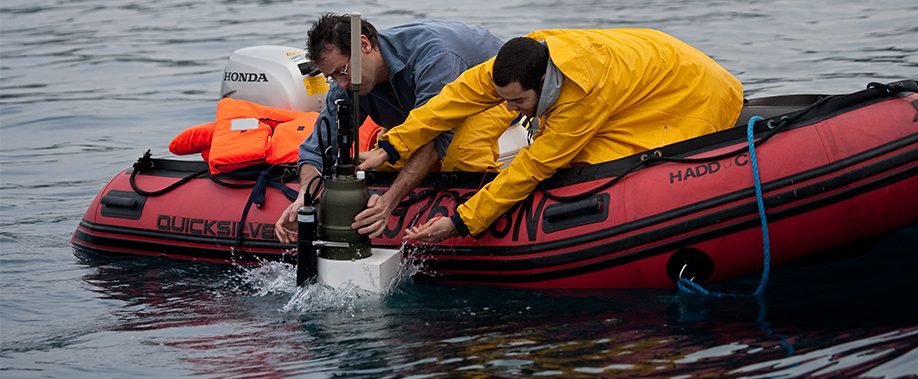Profiling floats

A profiling float is a cylinder-shaped submersible robot equipped with specific physical and/or biogeochemical sensors. Used as an autonomous platform to sample and observe Ocean properties (e.g. temperature, salinity, concentration in chlorophyll-a, oxygen, nitrates, particles and colored dissolved substances), in particular in remote oceanic areas, it is able to dive as deep as 2000 meters and profiles the water column in a yo-yo pattern.
The profiling float moves by changing its buoyancy, which mainly is achieved by a change in its overall volume. As for a glider, to descend, a valve opens allowing a certain volume of oil to be pumped from an outside flexible bladder into its interior. The float volume decreases, while its mass remains the same: that lowers its buoyancy and makes it sink. In the reverse process, the profiling float rises.
The Argo program is an international initiative that aims at deploying and maintaining an array of ~3000 profiling floats scattered across the global Ocean. Each of them provides measurements of sea temperature and salinity. In a standard cycle a profiling float belonging to the Argo program performs one measurement profile every 10 days, and stays in a “deep water parking position” during the other ca. 9 days. With such a temporal resolution, the autonomy of a profiling float generally ranges between 2 to 4 years. This allows to undertake investigations from a monthly-seasonal to the inter-annual time scale.
The observations acquired are periodically transmitted in near real-time to a marine laboratory on land. Data transfer is undertaken through Argos transmission system, or, more recently for specific profiling floats, through iridium telemetry when the float surfaces. During surfacing the antenna rises for optimal communication and reception of the GPS location. For the iridium-equipped floats, scientists have the opportunity to send new instructions to the profiling float as e.g. changes in mission parameters.
Given their specific functioning and longevity as well as the possibility to deploy them in remote oceanic regions, profiling floats are considered as cost-effective scientific platforms to acquire data. Particularly adapted for open Ocean and global-scale applications, profiling floats serve to collect and record an immense amount of information from which trends related to climate change can possibly extracted.
Technical details of a profiling float used as a scientific platform |
|
|
Hull size |
~1.5–1.9 m |
|
Weight |
~50 kg |
|
Energy |
batteries |
|
Velocity |
vertical: 10 cm/s |
|
Depth range |
0-2000 m |
|
Max. mission duration |
~300 profiles, |
|
Max. mission range |
thousands of km |
|
Passive navigation with currents/(Langrangian) |
GPS, cock |
|
Temporal scale |
diel to seasonal and interannual |
|
Deployment |
from ships, in all Oceans |
|
Examples of measurements |
temperature, salinity, |